Panel 1
Emiliano Agrillo, Roberto Inghilesi, Alessandro Mercatini, Alice Pezzarossa, Nazario Tartaglione
The indicator examines the series of data relating to forest areas affected by large fires on a national, regional and protected area scale over the period 2018 to 2024.
The distribution and extent of forest areas affected by fires generally show significant interannual variability. In particular, 2024 was a year less severely affected by the extent of forest areas impacted by fires compared to previous years. The forest area burned was higher only than that burned in 2018 and 2019, but significantly lower than all the years from 2020 to 2023.
In 2024, the most affected regions were Sicily (2,588 ha), Calabria (2,494 ha) and Sardinia (1,734 ha), which together accounted for 66% of the total national forest area affected by fires.
The most affected forest classes are evergreen broadleaved forests (e.g., holm oak woods and Mediterranean scrub), followed by deciduous broadleaved forests (e.g., oak and beech forests), and much less by coniferous forests (e.g., pine, fir, and larch forests).
Linear regression analysis of the national forest cover series affected by fires does not show an increasing trend, although the size of the series does not allow for medium- and long-term evaluations. A weak but statistically significant increasing trend was instead observed for the regions of Apulia, Basilicata and Calabria.
The indicator (status and changes) shows the extent of forest areas affected annually by large wildfires since January 1, 2018. The data are disaggregated by forest ecosystem type and by level of aggregation: national, regional, and protected natural areas.
The indicator is based on data provided by the European Forest Fire Information System (EFFIS) which, since 2018, thanks to the new generation of multispectral MSI sensors hosted on the Sentinel-2 satellite, has been able to detect fires of at least 1 hectare in size, achieving an accuracy of nearly 95% in identifying burned areas at the European level. To assess the impact of fires on different types of forest cover, the fire perimeter data provided by EFFIS are overlaid here with pre-existing forest cover data produced by ISPRA based on machine learning classification models (ECM-F4 product). The forest cover classes correspond to EUNIS nomenclature (latest update 2021) levels II and III: T1 - deciduous broadleaved forests (e.g., oak and beech forests); T2 - evergreen broadleaved forests (e.g., holm oak woods and Mediterranean scrub); T3 - coniferous forests (e.g., fir and pine forests); T34 - temperate subalpine forests (e.g., larch forests). Forests not classified by the ECM-F4 model are included under code TNC (unclassified forest surfaces class).
To provide useful information for assessing the status of forest ecosystems following major wildfire events in terms of forest areas affected by fires.
Legge 21 novembre 2000, n. 353 (Legge quadro in materia di incendi boschivi)
Legge n.155 del 08.11.21, avente come primo articolo le ”Misure urgenti per il rafforzamento del coordinamento, l’aggiornamento tecnologico e l’accrescimento della capacità operativa nelle azioni di previsione, prevenzione e lotta attiva contro gli incendi boschivi”.
Legge 28 giugno 2016, n. 132, Istituzione del Sistema Nazionale a rete per la Protezione dell'Ambiente e disciplina dell'Istituto Superiore per la Protezione e la Ricerca Ambientale (vd. Art. 11)
DM (MASE) n. 84.2025 - Direttiva generale concernente lo svolgimento delle funzioni e dei compiti facenti capo all’ISPRA per il triennio 2025-2027 (vd. Art.2 Linee prioritarie dell’azione di supporto al Ministero dell’ambiente e della sicurezza energetica, XI. Sistemi informativi geografici e cartografia per la tutela dell’ambiente, punto b)
Delibera del Consiglio SNPA. Seduta del 18.05.2021 (Doc. n. 108/21 - Operatività, ambiti di intervento e mappatura delle competenze specialistiche nella gestione delle emergenze ambientali del SNPA)
Delibera della Conferenza Stato-Regioni del 17 dicembre 2009, https://www.mite.gov.it/sites/default/files/archivio/normativa/dm_27_04_2010.pdf
Panel 2
Agrillo E, Filipponi F, Pezzarossa A, Casella L, Smiraglia D, Orasi A, Attorre F, Taramelli A. (2021). Earth Observation and Biodiversity Big Data for Forest Habitat Types Classification and Mapping. Remote Sensing. 2021; 13(7):123.
E. Agrillo, F. Filipponi, R. Inghilesi, A. Mercatini, and A. Pezzarossa. Monitoraggio dei cambiamenti degli ecosistemi forestali in Italia. Technical report, Istituto Superiore per la Protezione e la Ricerca Ambientale, 2022.
Agrillo E, Filipponi F, Pezzarossa A, Casella L, Smiraglia D, Orasi A, Attorre F, Taramelli A. (2021). Earth Observation and Biodiversity Big Data for Forest Habitat Types Classification and Mapping. Remote Sensing. 2021; 13(7):123.
E. Agrillo, F. Filipponi, R. Inghilesi, A. Mercatini, and A. Pezzarossa. Monitoraggio dei cambiamenti degli ecosistemi forestali in Italia. Technical report, Istituto Superiore per la Protezione e la Ricerca Ambientale, 2022.
Barbosa, P., Kucera, J., Strobl, P., Vogt, P., Camia, A., & San-Miguel-Ayanz, J. S. (2006). European Forest Fire Information System (EFFIS) Rapid damage assessment: Appraisal of burnt area maps in southern Europe using MODIS data (2003-2005). Forest Ecology and Management, 234(1), S218.
Barredo, J. I., Brailescu, C., Teller, A., Sabatini, F. M., Mauri, A., & Janouskova, K. (2021). Mapping and assessment of primary and old-growth forests in Europe. Publications Office of the European Union, Luxembourg.
Blasi, C., Burrascano, S., Maturani, A., & Sabatini, F. M. (2010). Foreste vetuste in Italia. Ministero dell’Ambiente e della Tutela del Territorio e del Mare: Roma, Italy.
Blasi, C., Bovio, G., Corona, P. M., Marchetti, M., & Maturani, A. (2004). Incendi e complessità ecosistemica. Dalla pianificazione forestale al recupero ambientale. https://www.mite.gov.it/sites/default/files/archivio/allegati/aib/incendi_e_complessita_ecosistemica.pdf
Cervellini, M., Zannini, P., Di Musciano, M., Fattorini, S., Jiménez-Alfaro, B., Rocchini, D., ... & Chiarucci, A. (2020). A grid-based map for the Biogeographical Regions of Europe. Biodiversity Data Journal, 8.
Chytrý, M. & co-authors (2020). EUNIS Habitat Classification: Expert system, characteristic species combinations and distribution maps of European habitats. Applied Vegetation Science, volume 23, issue 4, pp 648-675
European Commission, Joint Research Centre, San-Miguel-Ayanz, J., Durrant, T., Boca, R. et al., Advance report on forest fires in Europe, Middle East and North Africa 2022, Publications Office of the European Union, 2023, https://data.europa.eu/doi/10.2760/091540
Schaminée, J.H.J., Chytrý, M., Hennekens, S.M., Janssen, J.A.M., Knollová, I., Marceno, C., Tichý, L. & data providers (2020). Support to EUNIS habitat classification revision IV. Report for the EEA - Framework Contract: EEA/NSS/17/002/Lot 1, specific contract No 3417/B2019/EEA6
Inventario Nazionale delle Foreste e dei serbatoi forestali di Carbonio, 2015
https://www.mase.gov.it/pagina/elenco-ufficiale-delle-aree-naturali-protette-0
https://www.mase.gov.it/pagina/rete-natura-2000
https://ec.europa.eu/environment/nature/natura2000/biogeog_regions/
The data underlying this indicator may differ from other national databases such as that of the Carabinieri Forestry Command – Forest Fire Information Unit, particularly with regard to small fires. In satellite products derived from models, some omissions may occur in detecting burned areas, for example due to excessive cloud cover, fire size and duration, fire type (e.g., crown or understory fire), mismatch between fire event and satellite overpass, or the physiognomy of the affected ecosystem. The ISPRA historical series on forest areas affected by large wildfires, based on high-resolution satellite observations, are homogeneous and statistically representative at national, regional and provincial level, although they may differ slightly from data obtained through heterogeneous analyses entirely or partly based on field observations.
To improve information on national forest and woodland covers involved, in the future, a more detailed thematic EUNIS legend will be applied to all current categories within the indicator.
For a complete assessment of the impact of fires on the health of tree and shrub cover, in addition to estimating the burned surface area, it would be useful to obtain data on biomass loss, fire severity, and the effects of each individual event on the affected covers.
In the future, with the availability of new products provided by the European earth observation satellite monitoring system (Copernicus LMS), it will be possible to define the biomass affected for each individual fire event.
Data quality assessment
EEA (European Environment Agency)
ISPRA (Italian Institute for Environmental Protection and Research)
ISTAT (Italian National Institute of Statistics)
JRC (Joint Research Centre)
MASE (Ministry of the Environment and Energy Security)
MiTE (Ministry for the Ecological Transition).
Fire area data are freely downloadable at: https://effis.jrc.ec.europa.eu/applications/data-and-services
National distribution data of burned areas by main forest categories: https://groupware.sinanet.isprambiente.it/prodotti-operativi-di-sorveglianza-ambientale/library/disturbance-agents/wildfires/burnt-areas-italian-terrestrial-ecosystem
National distribution data for forest categories (Ecosystems Classification Model Forest4 ECM-F4): https://groupware.sinanet.isprambiente.it/prodotti-operativi-di-sorveglianza-ambientale/library/ecosystems-classification-model
EUNIS 2021 legend data: https://www.eea.europa.eu/data-and-maps/data/eunis-habitat-classification-1
Administrative unit data: https://www.istat.it/it/archivio/222527
Protected area data from EEA: https://www.eea.europa.eu/data-and-maps/data/nationally-designated-areas-national-cdda-17 and https://www.eea.europa.eu/data-and-maps/data/natura-13
Ramsar site data: http://wms.pcn.minambiente.it/ogc?map=/ms_ogc/wfs/RAMSAR.map
Biogeographical region data: https://zenodo.org/record/3934970#.Y00m8y8QM6l
Old-growth forest data: https://publications.jrc.ec.europa.eu/repository/handle/JRC124671
National, Regional
2018-2024
Indicator assessment
The time series of annual values of forest areas affected by large fires at national, regional and protected natural area levels have been analyzed using standard statistical methods (mean and linear regression), in order to assess the existence of trends, as well as variability and general characteristics of the phenomenon at different spatial scales.
Analysis of the time series of total burned areas provided by ISTAT since 2000 shows that 2007, 2017 and 2021 correspond to exceptional events (outliers) due to the overall extent of affected areas. For this reason, considering that the ratio between total and forest burned areas remains relatively stable, the year 2021 has been excluded from statistical analyses performed for trend assessment in the present indicator.
The stochastic component of the phenomenon, which affects the analysis, clearly emerges from the series. Therefore, the significance of trend results was primarily verified. Where no significant trend was observed, system status evaluation was discussed by comparing the current indicator value with the mean value over the considered period.
The methodology used to build the indicator since 2018 is based on evaluating burned areas by distinguishing between different forest ecosystem classes. To obtain a quantitative assessment of burned forest covers, polygons corresponding to areas burned as identified by EFFIS were combined with the distribution of forest categories obtained from the Ecosystems Classification Model - Forest4 (ECM-F4) developed by ISPRA. These forest classes follow the EUNIS (European Nature Information System – latest 2021 update) nomenclature at levels II and III:
- T1 – deciduous broadleaved forests (e.g., oak and beech forests);
- T2 – evergreen broadleaved forests (e.g., holm oak woods and Mediterranean scrub);
- T3 – coniferous forests (e.g., fir and pine forests);
- T34 – temperate sub-alpine forests (e.g., larch forests).
Forests not classified by the ECM-F4 model are included under code TNC (unclassified forest surface class). The EFFIS polygons and the other spatial datasets used were reprojected into a unified metric decimal coordinate system to calculate statistics for the various thematic classes. Annual values of burned area in the various classes were calculated at national and regional level, within protected natural areas of the EUAP network (Official List of Protected Areas) established by the State-Regions Conference resolution of December 17, 2009 (National Parks; Regional Parks; State Reserves; Regional Reserves), and within Natura 2000 sites: Special Areas of Conservation (SACs) and Special Protection Areas (SPAs).
The effects of wildfires were also considered for wetlands under the Ramsar Convention, old-growth forests, and biogeographical regions (alpine, continental, and Mediterranean).
Using specific spatial analysis tools on QGIS, the surface area of each forest class mapped by ECM-F4 for the identified intersection areas was calculated. Geostatistical processing was performed using GRASS GIS, Bash, R and QGIS software.
For protected natural areas, burned area estimates were carried out separately within each category. Indeed, overlapping institutional boundaries exist due to different administrative acts defining the EUAP and Natura 2000 networks, resulting in overlapping areas within and between the two systems. In this case, EFFIS polygons of burned areas were intersected (thematic overlay) with the polygons of the various considered themes, and then all areas belonging to the same type were merged to avoid double counting of the same surface.
At the national level, in the period 2018–2024, the average annual burned area amounts to 10,581 ha.
In 2024, 10,314 ha of forest area were burned nationally, a value almost equal to the average for the period considered. Since 2024 recorded a total burned forest area significantly lower than the three previous years, the status of forest area affected by fires in Italy for 2024 can be considered medium.
At regional level, in Basilicata, Calabria, Campania, Friuli Venezia-Giulia, Lazio, Marche, Molise, Apulia and Sardinia, the status is negative because the 2024 value exceeds the period average. In all other regions, the forest area burned in 2024 is lower than the period average.
For protected area categories, in 2024, forest areas burned exceeded the historical series average for: State Nature Reserves, Regional Nature Reserves, Other Protected Natural Areas, and Ramsar Sites.
Overall, the indicator status was therefore assessed as medium at national level.
The linear regression analysis of the national forest cover burned data series for 2018, 2019, 2020, 2022, 2023 does not show any significant trend.
The decrease in burned area compared to the previous three years is clearly visible in Figure 1, as is the exceptional nature of 2021. At regional level, trend evaluations show significant differences.
A statistically significant increasing trend was calculated for Basilicata, Calabria and Apulia. The 2021 data was excluded from regression analysis as it was considered an exceptional event.
Trend analyses for the remaining Italian regions and for all protected area categories considered by the indicator proved to be of low statistical significance.
Data
Table 1: Areas of main forest categories affected by fires at regional level
ISPRA processing based on ISPRA and JRC data
TNC: burned area of unclassified forests;
T1: burned area of deciduous broadleaved forests;
T2: burned area of evergreen broadleaved forests;
T3: burned area of coniferous forests;
T34: burned area of temperate sub-alpine forests;
TOT: sum of TNC, T1, T2, T3, and T34.
Table 2: Area of the main forest categories affected by fire in the different categories of protected areas and old-growth forests (2018)
ISPRA elaboration on ISPRA and JRC data.
TNC: burned area of unclassified forests; T1: burned area of deciduous broadleaf forests; T2: burned area of evergreen broadleaf forests ; T3: burned area of coniferous forests ; T34: burned area of sub-alpine temperate forests; TOT: sum of TCN, T1, T2, T3 and T34.
The calculations made for individual protected area categories are made without considering overlaps between them. So it is possible to make sums within the different categories but not between them; alternatively, there would be a risk of overestimating burned areas, particularly between EUAP and Natura 2000 categories.
Table 3: Area of the main forest categories affected by fire in the different categories of protected areas and old-growth forests (2019)
ISPRA elaboration on ISPRA and JRC data.
TNC: burned area of unclassified forests; T1: burned area of deciduous broadleaf forests; T2: burned area of evergreen broadleaf forests ; T3: burned area of coniferous forests ; T34: burned area of sub-alpine temperate forests; TOT: sum of TCN, T1, T2, T3 and T34
The calculations made for individual protected area categories are made without considering overlaps between them. So it is possible to make sums within the different categories but not between them; alternatively, there would be a risk of overestimating burned areas, particularly between EUAP and Natura 2000 categories.
Table 4: Area of the main forest categories affected by fire in the different categories of protected areas and old-growth forests (2020)
ISPRA elaboration on ISPRA and JRC data.
TNC: burned area of unclassified forests; T1: burned area of deciduous broadleaf forests; T2: burned area of evergreen broadleaf forests ; T3: burned area of coniferous forests ; T34: burned area of sub-alpine temperate forests; TOT: sum of TCN, T1, T2, T3 and T34
The calculations made for individual protected area categories are made without considering overlaps between them. So it is possible to make sums within the different categories but not between them; alternatively, there would be a risk of overestimating burned areas, particularly between EUAP and Natura 2000 categories.
Table 5: Area of the main forest categories affected by fire in the different categories of protected areas and old-growth forests (2021)
ISPRA elaboration on ISPRA and JRC data.
TNC: burned area of unclassified forests; T1: burned area of deciduous broadleaf forests; T2: burned area of evergreen broadleaf forests ; T3: burned area of coniferous forests ; T34: burned area of sub-alpine temperate forests; TOT: sum of TCN, T1, T2, T3 and T34
The calculations made for individual protected area categories are made without considering overlaps between them. So it is possible to make sums within the different categories but not between them; alternatively, there would be a risk of overestimating burned areas, particularly between EUAP and Natura 2000 categories.
Table 6: Area of the main forest categories affected by fire in the different categories of protected areas and old-growth forests (2022)
ISPRA elaboration on ISPRA and JRC data.
TNC: burned area of unclassified forests; T1: burned area of deciduous broadleaf forests; T2: burned area of evergreen broadleaf forests ; T3 burned area of coniferous forests ; T34 burned area of sub-alpine temperate forests
The calculations made for individual protected area categories are made without considering overlaps between them. So it is possible to make sums within the different categories but not between them; alternatively, there would be a risk of overestimating burned areas, particularly between EUAP and Natura 2000 categories.
Table 7: Area of the main forest categories affected by fire in the different categories of protected areas and old-growth forests (2023)
ISPRA elaboration on ISPRA and JRC data.
TNC: burned area of unclassified forests; T1: burned area of deciduous broadleaf forests; T2: burned area of evergreen broadleaf forests ; T3 burned area of coniferous forests ; T34 burned area of sub-alpine temperate forests
The calculations made for individual protected area categories are made without considering overlaps between them. So it is possible to make sums within the different categories but not between them; alternatively, there would be a risk of overestimating burned areas, particularly between EUAP and Natura 2000 categories.
Table 8: Areas of main forest categories affected by fires in the various categories of protected areas and old-growth forests (2024)
ISPRA processing based on ISPRA and JRC data
TNC: burned area of unclassified forests;
T1: burned area of deciduous broadleaved forests;
T2: burned area of evergreen broadleaved forests;
T3: burned area of coniferous forests;
T34: burned area of temperate sub-alpine forests
Calculations carried out for individual protected area categories do not take into account overlaps between them. Therefore, it is possible to sum values within each category, but not between different categories; otherwise, there is a risk of overestimating burned areas, especially between EUAP categories and Natura 2000 Network categories.
ISPRA processing based on ISPRA and JRC data
TNC: unclassified forests;
T1: deciduous broadleaved forests;
T2: evergreen broadleaved forests;
T3: coniferous forests;
T34: temperate sub-alpine forests
ISPRA processing based on ISPRA and JRC data
Forest area affected by fires broken down by biogeographical regions in percentage (bar chart columns) and forest area affected by fires in Italy in hectares (black line)
Figure 4: National area of main forest categories affected by fires within protected natural areas (EUAP)
ISPRA processing based on ISPRA and JRC data
TNC: unclassified forests;
T1: deciduous broadleaved forests;
T2: evergreen broadleaved forests;
T3: coniferous forests;
T34: temperate sub-alpine forests
The EUAP considered refer to the official list of protected areas, see State-Regions Conference Resolution of December 17, 2009. Only terrestrial EUAP areas have been considered.
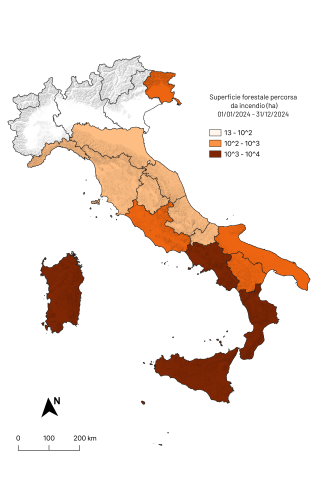
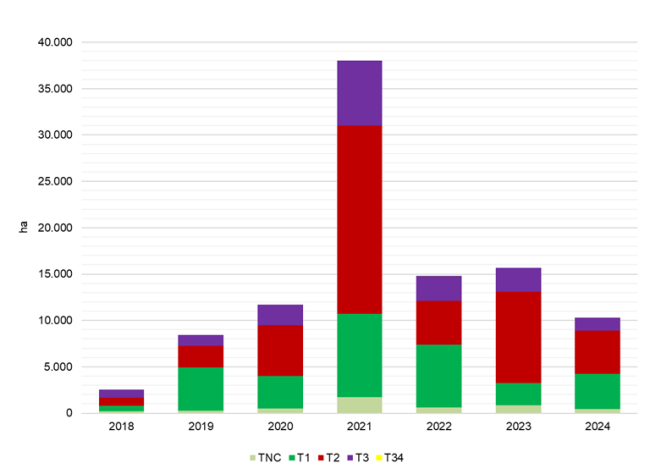
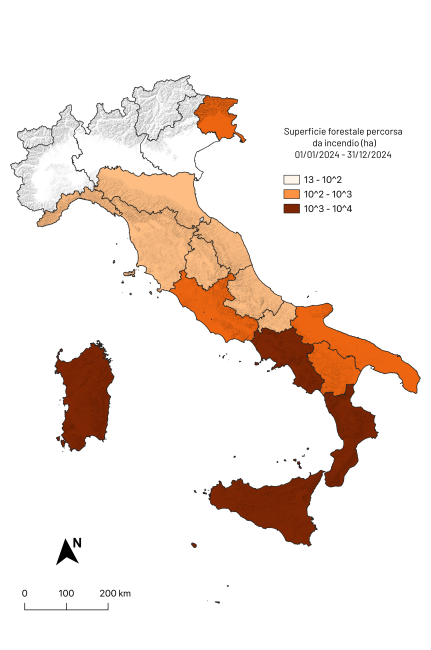
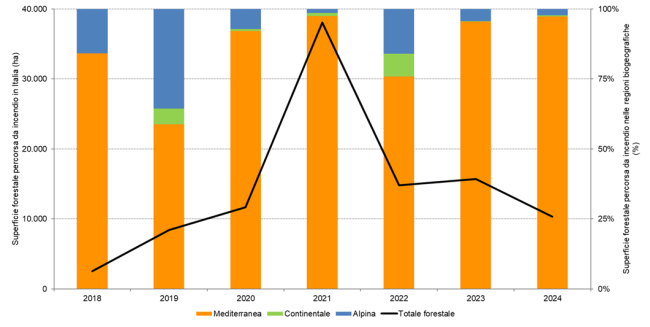
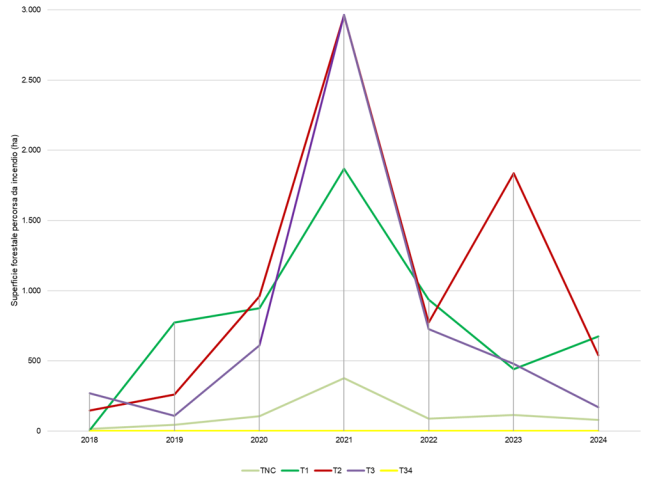
The wildfires that occurred in Italy in 2024 were less severe in terms of forest area affected compared to previous years.
The total area burned in 2024 exceeded only that of 2018 and 2019 but was significantly lower than all years from 2020 to 2023 (Figure 1). Figures are much lower than in 2023, with a 34% decrease in burned forest area. Between 2018 and 2024, the most affected forest category nationally was evergreen broadleaved forests (T2 – mainly holm oak woods and Mediterranean scrub); followed by deciduous broadleaved forests (T1 – mainly oak forests) and coniferous forests (T3 – mainly pine forests) in second and third place. This result does not correspond to the relative abundance estimates of forest covers nationwide, where deciduous broadleaved forests are the most widespread in Italy (National Forest Inventory and Forest Carbon Reservoirs, 2015).
The region with the highest growth trend is Calabria with 550 ha per year.
Apulia has the lowest increasing trend, with approximately 62 ha per year.
As shown in Figure 2, the regions with the largest forest areas affected by fires in 2024 are Sicily (2,588 ha), Calabria (2,494 ha), Sardinia (1,743 ha), Campania (1,175 ha). These four regions together account for 66% of the total national forest capital that burned. In Sicily and Sardinia, evergreen broadleaved forests (T2), mainly holm oak woods and Mediterranean scrub, were primarily affected. In Calabria, deciduous broadleaved forests (T1), mainly mixed oak forests, were mostly affected.
Valle d’Aosta, Lombardy, Trentino-Alto Adige, and Veneto did not record any burned areas in 2024 (Table 1).
As shown in Figure 3, over the period considered, the biogeographical region with the largest forest area affected by fires was the Mediterranean region. The largest burned forest area in the Alpine biogeographical region occurred in 2019, while for the Continental biogeographical region it was in 2022. In 2024, 97% of the forest areas affected by fires were located in the Mediterranean biogeographical region. With regard to the national protected area system, analysis of the historical series shows that even in 2024, Special Areas of Conservation were the category with the largest burned forest area (Tables 2–8).